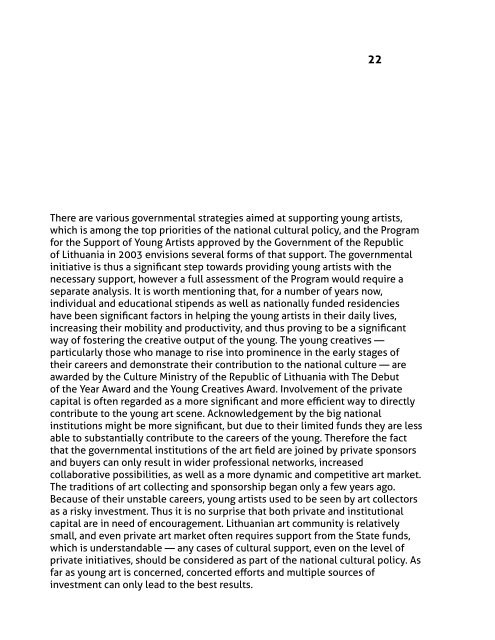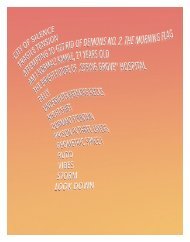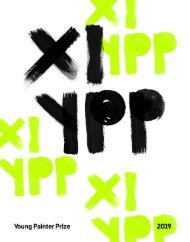X YPP Book
The main aim of the project - to discover new talent in Baltic States.
The main aim of the project - to discover new talent in Baltic States.
You also want an ePaper? Increase the reach of your titles
YUMPU automatically turns print PDFs into web optimized ePapers that Google loves.
There are various governmental strategies aimed at supporting young artists,<br />
which is among the top priorities of the national cultural policy, and the Program<br />
for the Support of Young Artists approved by the Government of the Republic<br />
of Lithuania in 2003 envisions several forms of that support. The governmental<br />
initiative is thus a significant step towards providing young artists with the<br />
necessary support, however a full assessment of the Program would require a<br />
separate analysis. It is worth mentioning that, for a number of years now,<br />
individual and educational stipends as well as nationally funded residencies<br />
have been significant factors in helping the young artists in their daily lives,<br />
increasing their mobility and productivity, and thus proving to be a significant<br />
way of fostering the creative output of the young. The young creatives —<br />
particularly those who manage to rise into prominence in the early stages of<br />
their careers and demonstrate their contribution to the national culture — are<br />
awarded by the Culture Ministry of the Republic of Lithuania with The Debut<br />
of the Year Award and the Young Creatives Award. Involvement of the private<br />
capital is often regarded as a more significant and more efficient way to directly<br />
contribute to the young art scene. Acknowledgement by the big national<br />
institutions might be more significant, but due to their limited funds they are less<br />
able to substantially contribute to the careers of the young. Therefore the fact<br />
that the governmental institutions of the art field are joined by private sponsors<br />
and buyers can only result in wider professional networks, increased<br />
collaborative possibilities, as well as a more dynamic and competitive art market.<br />
The traditions of art collecting and sponsorship began only a few years ago.<br />
Because of their unstable careers, young artists used to be seen by art collectors<br />
as a risky investment. Thus it is no surprise that both private and institutional<br />
capital are in need of encouragement. Lithuanian art community is relatively<br />
small, and even private art market often requires support from the State funds,<br />
which is understandable — any cases of cultural support, even on the level of<br />
private initiatives, should be considered as part of the national cultural policy. As<br />
far as young art is concerned, concerted efforts and multiple sources of<br />
investment can only lead to the best results.<br />
22<br />
THE YOUNG PAINTER PRIZE: CHANGES<br />
The Young Painter Prize was conceived precisely as an initiative that consolidates<br />
various participants of the art field, and it proved to be one of the most<br />
successful non-institutional projects of that kind. Notably, its birth coincided<br />
with the financial crisis of 2009 that affected all aspects of the country’s life,<br />
obviously including its culture sector as well. In order to bring their project to<br />
life, the organisers — painter Vilmantas Marcinkevičius art theorist Julija<br />
Dailidėnaitė — had to face difficult conditions. While institutions were busy<br />
adopting the austerity measures, the organisers had to look for the alternative<br />
ways to reinvigorate the art market. The nation-wide financial slowdown has<br />
also led to the formation of trans-institutional cooperation and non-institutional<br />
initiatives. When the art market started stagnating, a relatively cheap work of the<br />
young artists proved to be a good source of interest for both art collectors and<br />
the general public, thus showing a potential for reinvigorating the art market.<br />
The organisers had ambitious goals: to showcase the most promising and<br />
outstanding young (younger than 30) painters; introduce the young artists to a<br />
wide public; and help art collectors, managers and curators discover new talents.<br />
After making a modest start in 2009 with the applications from 28 Lithuanian<br />
artists, in 2011 the <strong>YPP</strong> Award turned international after it opened its doors to<br />
the young painters of Latvia and Estonia. Over a period of a decade, the <strong>YPP</strong><br />
Award grew into a one of the biggest annual events in the Lithuanian art scene.<br />
The <strong>YPP</strong> Award remains one of the most successful examples of both<br />
institutional and non-institutional collaboration between the governmental<br />
and private sectors. By taking part in the Award Committee and making efforts<br />
to promote and ensure the continuity of <strong>YPP</strong>, the institutional partners are also<br />
contributing to the buildup of its so-called ‘symbolic capital,’ while sponsors and<br />
patrons are taking care of <strong>YPP</strong>’s material basis. The Award winners are motivated<br />
both financially (in the form of cash prizes, residency invitations, and solo shows)<br />
and symbolically (through prominence and exposure). While young artists<br />
often tend to take their accomplishments with a pinch of salt, they also admit<br />
that acknowledgement is always pleasant and inspiring. Therefore art<br />
competitions are regarded not only as sources of financial incentives but also as<br />
a way to build an identity and become acknowledged by the art world<br />
professionals, the press, and the general public. For an up-and-coming artist,<br />
publicity and promotion are among the most important career catalysts. Thanks<br />
to today’s technological advancements, artists are able to publicise and share<br />
their work via online galleries and social networks thus reaching out to their<br />
audiences independently. However most of the up-and-coming artists are lacking<br />
in the capacity to present their work professionally. Meanwhile the <strong>YPP</strong> Award<br />
receives a wide press coverage and dominates both public and private discourses<br />
among the art professionals, and it certainly contributes to the popularisation<br />
and promotion of young art. The participants get noticed by the art critics,





